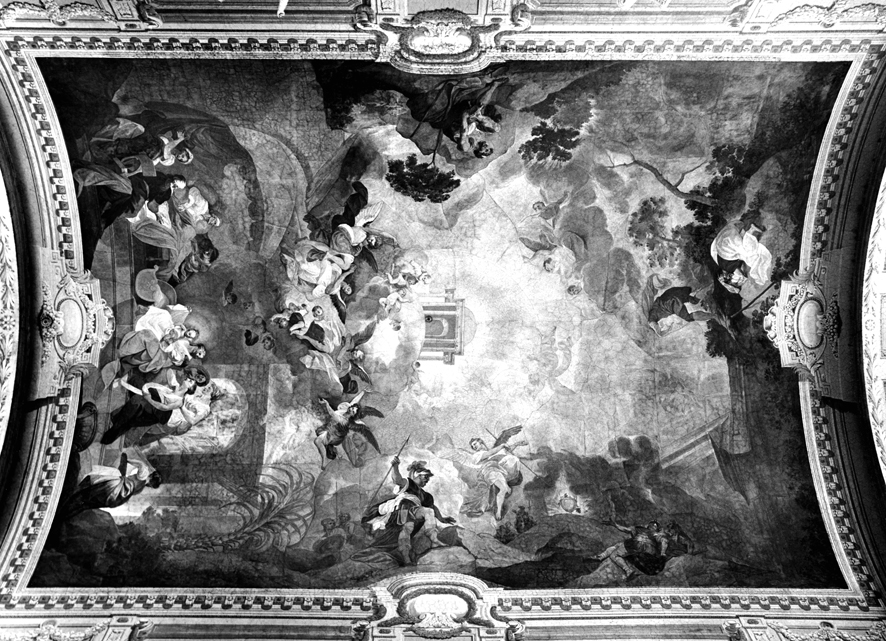

Click to read in Hungarian >>

This begins a new web page that will address the issue of some of the Art and ceiling Frescos of the cathedral that were lost on the morning of March 4, 1945. For those who had attended this Morning Service on that fateful Sunday, probably would have never thought, that in two short hours all that they observed sitting in the pews that day, would be gone in an instant at 12:42 pm., when the first group of bombers of the 485th. Bomb Group of the 15th. Army Air Corps arrived over the City of Szombathely.
Through the use of photographs that have remained to us today, you can now revisit some of these ceiling Frescos, as these very same paintings then, were probably just noticed by those attending, who had casually glanced upward. And without giving a moment’s thought, they would indeed be the last to see these magnificent paintings.
As with all of the other content on this website, the following material will be presented in two languages. I wish to thank again my “translators” who have given of their time so freely over these past many years. Without their help both here in the United States and in Hungary, none of this would have been possible.

Note: The Nave Fresco was Barrel Vaulted, and the Crossing and the Sanctuary Frescos, were Dome Vaulted. No notations of height were given. Measurements used in this paper are approximate values only based on a flat Floor Plan. No Elevations Plans were available here at this writing. Volumes quoted here would then be slightly “less” of actual conditions.
Standing in the middle of the Nave (looking upward) the front doors are to your right and the Crossing is on your left. The Soldier at the bottom/center would be sitting on his rocks over the North Wall of the Nave.
The themes of this Fresco, are the scenes from the life of the Virgin Mary. The first Bishop of this Cathedral was Bishop Szily Janos, wh0 then was devoted to her and this very same original fresco was the last great example of the Baroque Art Form on Hungarian soil. It was painted by the artist Spreng in 1807-1808 and based on the color sketches of Maulbertsch for a fee of 3,400 forints. (a very handsome sum in those days).

Standing at the very front of the Nave just below the Arch of the Crossing Cupola (which will follow), we look back into the whole Nave and directly upwards. The enlarged sectional image above, was taken from “the full length image” and has been slightly enlarged to show more details. The contrast levels were enhanced to reveal more detail, while the imperfections of artifacts, and dust on the negative were removed. The above (rotated) orientation has been changed for easier viewing the painting’s details.
The main theme of this fresco can be found in the above view. St. Ann can be seen lying on a Canopy Bed of pillows with women attending her. At center, the Virgin Mary with a “Gloria” about her head, and women sitting about her on the steps in full adoration holding garments, and in the lower right corner, a young woman is visible carrying a large bowl of water up the steps. Through the Arch at the right, a view of a city structure of a more modern design can be seen, and not of 2000 years ago. (Conjecture: perhaps a cityscape of a building in Szombathely or Vienna). Angels adorn in the clouds above the new born and at the center top, a “Temple” on a mountain high from the Old Testament. A close observation of the door to the temple, is a round “spot” (on the left) of the door arch which is an opening for a long cable that could be raised or lowered that held a large candle chandelier over the center isle of the Nave in days before electrification.

Standing at the very back of the Nave just below the Arch, and in front of the glass wall/doors below the organ loft, we look back into the Nave and directly upwards. The enlarged sectional image above was again taken from “the full length image” and has been slightly enlarged to show more details. The contrast levels were enhanced to show more detail, while the imperfection of artifacts, and dust on the negative were removed. The orientation has been changed for easier viewing. Tonal corrections were also made to enhance the condition of the ceiling plaster, which showed the signs of deterioration after many, many years.
This portion continues with more Old Testament prophesies and visualizations of the Temple, the Burning Bush (left side), Noah’s Ark (left corner), and the Flood. Other visualizations on the right can also be seen, Cain and Abel (Bottom) but not noted independently by the author - Dr. Gefin Gyula. (in 1945)
